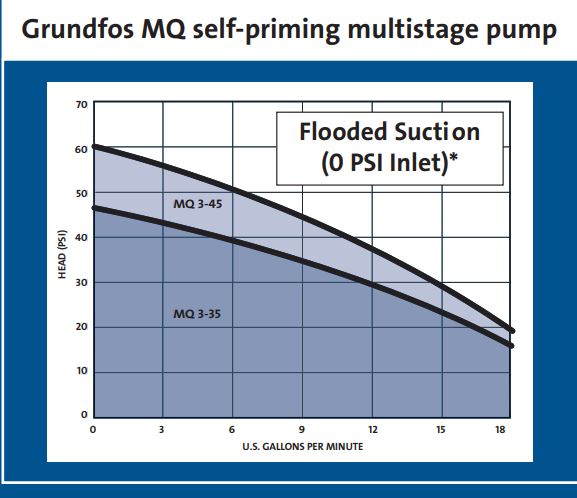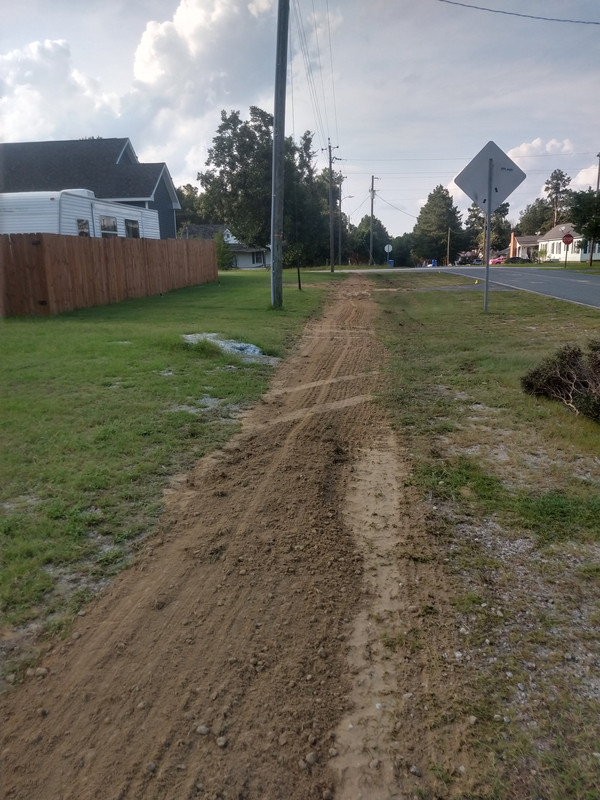I'm currently sort of in the R & D stage of wanting to build an irrigation system at my house. At this point I'm just researching and learning, and dabbling with designing it on paper. I've read through Stryker's tutorial several times, and spent even more time on certain topics reviewing the material further.
The purpose of this post is how a booster pump may benefit me. I currently have a 3/4 irrigation meter, at which I see 32 psi static pressure and I get 7.5 gpm with a bucket test right at the meter.
The other meter I have servicing my house also gives me 32 psi and 7.5 gpm.
I've been through the pumps section of the tutorial quite a few times. I think I understand most of it, I understand the pump curves and how to decipher pump ratings and compare that to your goals.
I would want to select a pump that gives approximately a 20 psi boost, but what I'm not totally sure about is how that will, or won't, affect my flow. The irrigation tutorial, almost from beginning to end, seems to assume that those with water from a municipality have ample flow, and talks more about not using too much flow (to keep speeds within the pipe at safe limits) than it talks about what to do if you don't have enough flow.
I've already run 2" main line from the irrigation meter, and plan to continue to do so as I work on plumbing it to the irrigation valves. I want to use 1" for my laterals, or if it will benefit me I'm fine using 1.25 or even 1.5.
If I select a pump that is rated at, we'll say 20 psi boost and 20 gpm, will it be able to bump my gpm up? Will it boost the pressure but not boost the flow? Will it perhaps even reduce the flow?
I have a 3/4 meter, and I think 3/4 pipe can safely flow up to about 20 gpm. So let's say 20 gpm is what 3/4 pipe can reasonably flow, would a pump be able to pull that much through the meter from the supply pipes?
Next door there is an irrigation system also with only about 32 psi, but he has 10 gpm, and his system seems to perform well.
I'm not sure if I want to jump through many hoops to only gain 2.5 gpm though. That only really allows me am average of one extra head per zone. It doesn't reduce the amount not pipe or plumbing work significantly, and I'm not sure it would make a big difference in the amount of time I have to run the system either.
So, I'm thinking, if I can't use a booster pump and get the flow to, perhaps, 15 gpm, I'm not sure it's a worthwhile endeavor.
If this is plausible, I'm guessing I certainly don't need the pump to be oversized. I guess if it's trying to pull much more flow than it's going to be able to, that would be bad for the pump and it may cavitate also?
I've been playing around calculating friction losses and whatnot on paper. It seems like with the right nozzles (that do coincidence with Stryker's recommendation for min flow rate nozzles) I can make this work with 20' spacing and 3 heads per zone, even with no pump. I think. So if it seems like I could probably make it work with no pump, I'm thinking I don't need huge improvements and a super duper really capable pump. If I could just boost my design pressure (and available pressure) to 45-50 psi, and manage 15-20 gpm, I'd be good to go.
Right now, I'm using 2 orbit 4 valve programmable timers, 3/4 water hose, and melnor impact sprinklers. I'm able to hide 90 percent of my hoses in my shrub beds and this has worked pretty well this summer to establish my sod and keep it doing well. I just am not able to hide ALL of my hoses and would like to be able to get away from hoses.
The purpose of this post is how a booster pump may benefit me. I currently have a 3/4 irrigation meter, at which I see 32 psi static pressure and I get 7.5 gpm with a bucket test right at the meter.
The other meter I have servicing my house also gives me 32 psi and 7.5 gpm.
I've been through the pumps section of the tutorial quite a few times. I think I understand most of it, I understand the pump curves and how to decipher pump ratings and compare that to your goals.
I would want to select a pump that gives approximately a 20 psi boost, but what I'm not totally sure about is how that will, or won't, affect my flow. The irrigation tutorial, almost from beginning to end, seems to assume that those with water from a municipality have ample flow, and talks more about not using too much flow (to keep speeds within the pipe at safe limits) than it talks about what to do if you don't have enough flow.
I've already run 2" main line from the irrigation meter, and plan to continue to do so as I work on plumbing it to the irrigation valves. I want to use 1" for my laterals, or if it will benefit me I'm fine using 1.25 or even 1.5.
If I select a pump that is rated at, we'll say 20 psi boost and 20 gpm, will it be able to bump my gpm up? Will it boost the pressure but not boost the flow? Will it perhaps even reduce the flow?
I have a 3/4 meter, and I think 3/4 pipe can safely flow up to about 20 gpm. So let's say 20 gpm is what 3/4 pipe can reasonably flow, would a pump be able to pull that much through the meter from the supply pipes?
Next door there is an irrigation system also with only about 32 psi, but he has 10 gpm, and his system seems to perform well.
I'm not sure if I want to jump through many hoops to only gain 2.5 gpm though. That only really allows me am average of one extra head per zone. It doesn't reduce the amount not pipe or plumbing work significantly, and I'm not sure it would make a big difference in the amount of time I have to run the system either.
So, I'm thinking, if I can't use a booster pump and get the flow to, perhaps, 15 gpm, I'm not sure it's a worthwhile endeavor.
If this is plausible, I'm guessing I certainly don't need the pump to be oversized. I guess if it's trying to pull much more flow than it's going to be able to, that would be bad for the pump and it may cavitate also?
I've been playing around calculating friction losses and whatnot on paper. It seems like with the right nozzles (that do coincidence with Stryker's recommendation for min flow rate nozzles) I can make this work with 20' spacing and 3 heads per zone, even with no pump. I think. So if it seems like I could probably make it work with no pump, I'm thinking I don't need huge improvements and a super duper really capable pump. If I could just boost my design pressure (and available pressure) to 45-50 psi, and manage 15-20 gpm, I'd be good to go.
Right now, I'm using 2 orbit 4 valve programmable timers, 3/4 water hose, and melnor impact sprinklers. I'm able to hide 90 percent of my hoses in my shrub beds and this has worked pretty well this summer to establish my sod and keep it doing well. I just am not able to hide ALL of my hoses and would like to be able to get away from hoses.






